Driving safely requires clear visibility, and windshield wipers are crucial for maintaining that, especially when the weather turns foul. Choosing the right wiper blades can significantly enhance your driving experience and safety. With so many options on the market, from traditional rubber blades to advanced silicone ones, and various designs like beam, branch, and hybrid, finding the best wiper blades for your vehicle can feel overwhelming. That’s why we’ve rigorously tested a range of windshield wipers to bring you a comprehensive guide to the best wiper blades of 2025, ensuring you can confidently select the perfect set for your needs and driving conditions.
Top Picks for the Best Windshield Wipers in 2025
To make your decision easier, we’ve broken down our top windshield wiper recommendations by category, considering different needs and budgets.
Best Overall Windshield Wipers: Rain-X Silicone Endura
![]() Rain-X Silicone Endura Windshield Wipers for best overall performance
Rain-X Silicone Endura Windshield Wipers for best overall performance
Rating: 9.1 / 10
Price: $26 per blade (Approx.)
Key Features:
- Wiper Style: Beam
- Blade Material: Silicone with Graphite Coating
- Available Lengths: 14-28 inches
- Attachment Types: J-hook, pinch tab, pinch tab button, pin arm, side pin
Pros:
- Superior silicone blade material lasts longer than traditional rubber.
- Graphite coating enhances smooth, streak-free wiping performance.
- Silicone blade technology applies a water-repellent coating to the windshield during operation.
- High pivot point design increases clamping force for consistent contact.
- Secure locking clasp for reliable attachment.
Cons:
- Higher price point compared to rubber wiper blades.
- May not be as widely available as other Rain-X models.
The Rain-X Silicone Endura wiper blades stand out as the best overall choice due to their exceptional blend of performance and durability. These beam-style wipers utilize a premium silicone blade, which is significantly more resistant to UV radiation, ozone, and temperature extremes compared to natural rubber. This material advantage translates to a longer lifespan and consistent performance over time.
What sets the Silicone Endura apart is its silicone blade’s ability to impart a Rain-X-like water-repellent treatment onto your windshield with every wipe. This hydrophobic effect causes water to bead and roll off, dramatically improving visibility in rain and reducing the need for frequent wiper use. In our tests, these wipers exhibited minimal streaking and operated remarkably quietly, even at high speeds. The performance even seemed to improve over time as the silicone coating built up on the windshield.
Installation is straightforward, although the J-hook attachment release can be a bit tricky at first. However, the robust mounting attachments and locking clasp ensure a secure and reliable fit. Interestingly, we observed that the Rain-X Silicone Endura blades are virtually identical to the PIAA Si-Tech wipers, our premium pick, suggesting they may even be manufactured by the same source. Given the Endura’s often lower price, they offer outstanding value for anyone seeking top-tier windshield wiper performance.
Best Budget Windshield Wipers: AERO Voyager J-Hook
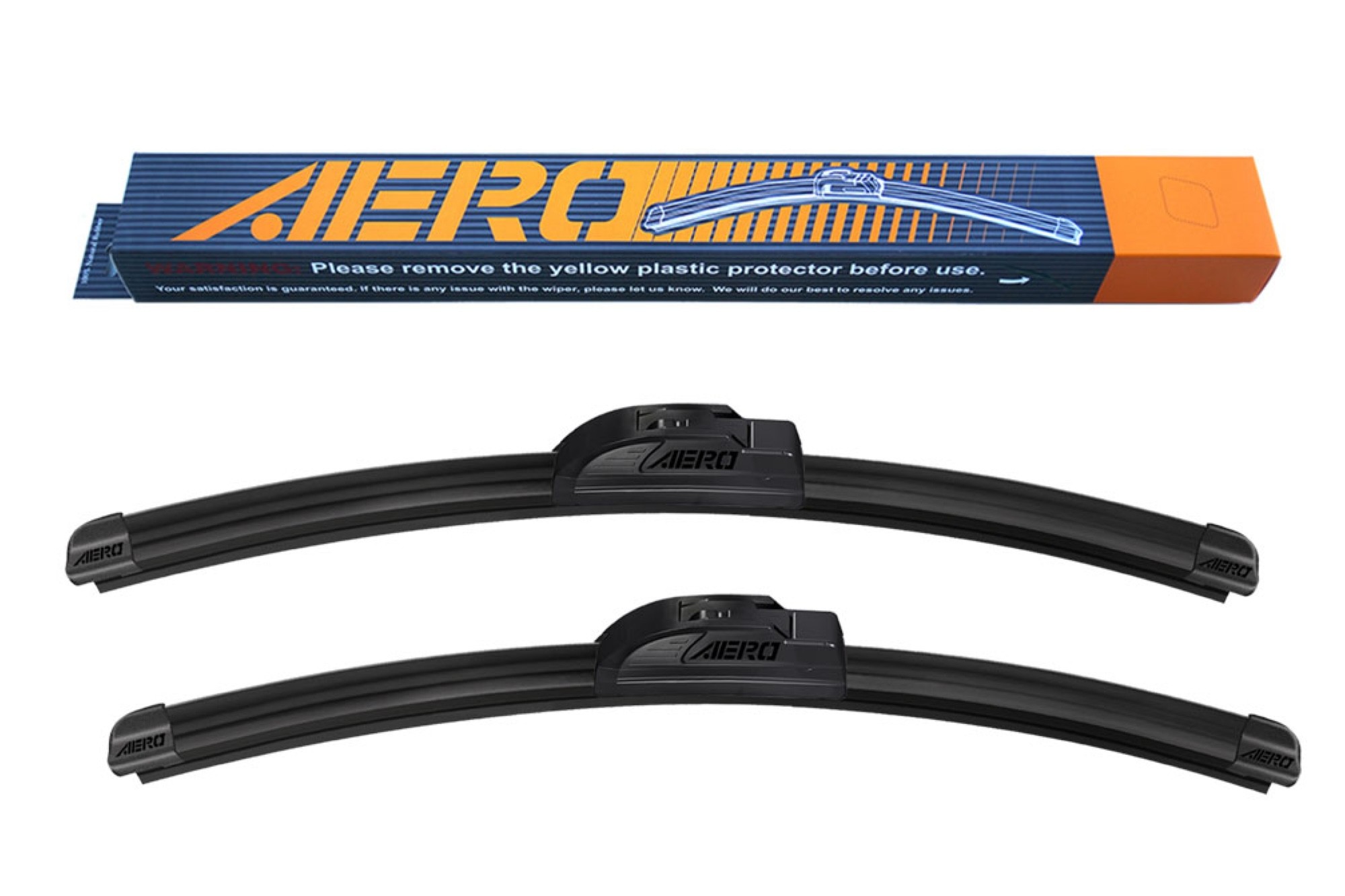 AERO Voyager J-Hook Windshield Wipers offering best budget performance
AERO Voyager J-Hook Windshield Wipers offering best budget performance
Rating: 6.1 / 10
Price: $17 per set of two (Approx.)
Key Features:
- Wiper Style: Beam
- Blade Material: Rubber with Teflon Coating
- Available Lengths: 13-28 inches
- Attachment Types: Small and large J-hook
Pros:
- Extremely affordable, especially as a set of two.
- DuPont Teflon coating reduces friction and improves wiping action.
- Includes an extra set of rubber wiper elements for extended use.
- Comes with a 1-year warranty, unusual for budget wipers.
- Aerodynamic beam design with wiper arm cover.
Cons:
- Limited to J-hook attachment style.
- Rubber blades may not clear water as effectively as silicone, potential for squeaking when dry.
The AERO Voyager J-Hook Wiper Blades redefine the budget category, delivering beam-style performance at an incredibly low price. For around $17, you get a pair of modern beam wipers, often costing less than a single premium blade. This exceptional value is further enhanced by the inclusion of a spare set of rubber wiper elements and a 1-year warranty, making them a smart and economical choice.
While the rubber blades may not match the water-clearing prowess of silicone, the Teflon coating significantly minimizes squeaking, a common issue with untreated rubber wipers. The beam design provides consistent pressure across the windshield, contributing to effective wiping performance despite the budget-friendly materials. The aerodynamic design and wiper arm cover are also unexpected features at this price point, adding to their overall value.
The AERO Voyagers are only compatible with J-hook wiper arms, which might limit their applicability for some vehicles. However, for J-hook equipped cars, these wipers offer an unbeatable combination of price, performance, and features, making them the best budget option for those seeking reliable windshield clearing without breaking the bank. The inclusion of replacement rubber elements also reflects a commendable effort towards environmental consciousness, extending the lifespan of the wipers and reducing waste.
Best Branch-Style Windshield Wipers: SilBlade Standard
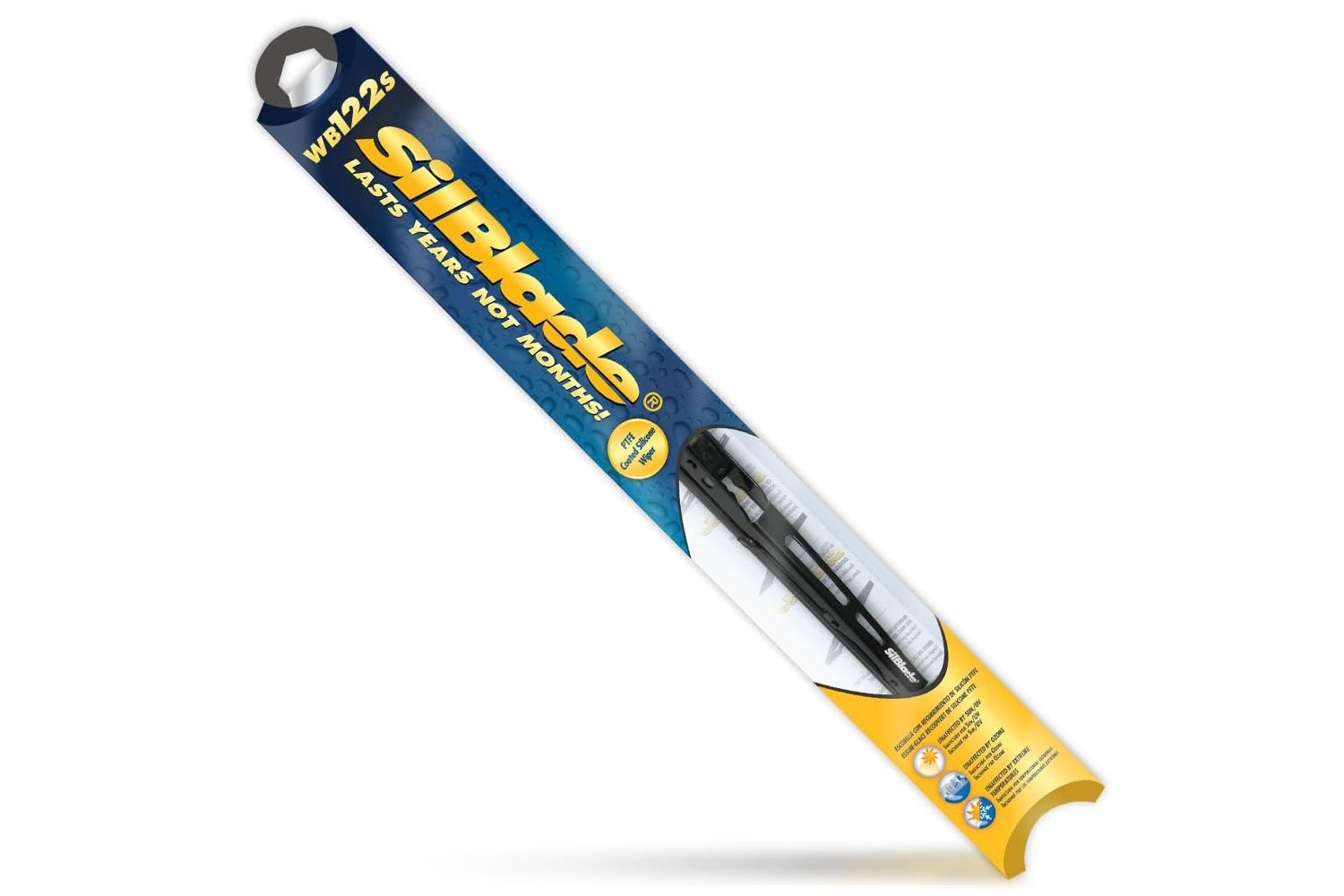 SilBlade Standard Windshield Wipers for best branch-style performance
SilBlade Standard Windshield Wipers for best branch-style performance
Rating: 6.8 / 10
Price: $26 per blade (Approx.)
Key Features:
- Wiper Style: Branch
- Blade Material: Silicone
- Available Lengths: 11-28 inches
- Attachment Types: J-hook, pin arm
Pros:
- Affordable silicone wiper option in a traditional branch-style design.
- Wide range of available lengths to fit various vehicles.
- Durable powder-coated steel frame, more robust than typical branch wipers.
Cons:
- Mounting hardware may feel less secure compared to beam wipers.
- Branch-style design less effective in heavy snow or icy conditions.
- Limited attachment options.
The SilBlade Standard wiper blades cater to those who prefer the traditional branch-style design but desire the benefits of silicone wiper blades. Typically, branch-style wipers come with cheaper rubber squeegees, but SilBlade bucks this trend by offering silicone blades at a competitive price. These wipers are an economical choice, especially for drivers in drier climates where beam-style performance might be overkill.
In our testing, the SilBlade Standards delivered mid-pack performance, exhibiting minimal streaking and noise, although some slight shuddering was noticeable at the end of the wipe stroke. For everyday driving, however, their performance is more than adequate. The silicone blade offers improved durability and longevity compared to rubber in a branch-style format.
Available in a broad spectrum of lengths, the SilBlades should fit a wide array of vehicles, though attachment options are limited to J-hook and pin arm types. The powder-coated steel frame is a step up in durability compared to many branch wipers. For those who prefer the familiar branch-style but want the advantages of silicone without the premium price of beam blades, the SilBlade Standard presents a compelling option. SilBlade also offers beam and hybrid designs for those looking for more modern wiper styles.
Best Beam-Style Windshield Wipers: Bosch Icon
![]() Bosch Icon Windshield Wipers for best beam-style performance
Bosch Icon Windshield Wipers for best beam-style performance
Rating: 8.9 / 10
Price: $30 per blade (Approx.)
Key Features:
- Wiper Style: Beam
- Blade Material: Rubber
- Available Lengths: 13-28 inches
- Attachment Types: J-hook, side-lock, pinch-tab, top-lock
Pros:
- Excellent beam design with optimal flexibility and windshield conformity.
- Easiest installation process among tested wipers, with a user-friendly locking clasp.
- Robust performance in cold weather, where silicone might be prone to tearing.
Cons:
- Traditional rubber blades may not match silicone performance in all conditions.
- Attachment type selection is not as extensive as some competitors.
The Bosch Icon wiper blades have earned their widespread popularity, and our tests confirmed their well-deserved reputation. These beam-style wipers represent a perfected design, featuring a smooth flex pattern and an aggressive curvature that ensures consistent contact with the windshield across its entire surface.
While we generally favor silicone blades for their superior performance, the rubber compound used in the Bosch Icons is undeniably high-quality. In our tests, these wipers cleared water effectively, even outperforming the Rain-X Latitude (rubber) blades in streak reduction. While long-term durability might be a slight trade-off compared to silicone, the build quality is exceptional.
One of the standout features of the Bosch Icons is their remarkably easy installation. The simple locking clasp mechanism secures the blade with a single motion, making them the most user-friendly wipers we tested. This is a significant advantage compared to many other wipers that can be fiddly and even pinch fingers during installation or removal. Furthermore, for drivers in extremely cold and icy climates, rubber blades like the Icons can be a better choice than silicone, which can become too soft and potentially tear when encountering ice buildup on unscraped windshields. For a top-performing beam-style wiper with exceptional ease of use, the Bosch Icon is an excellent choice.
Best Premium Windshield Wipers: PIAA Si-Tech
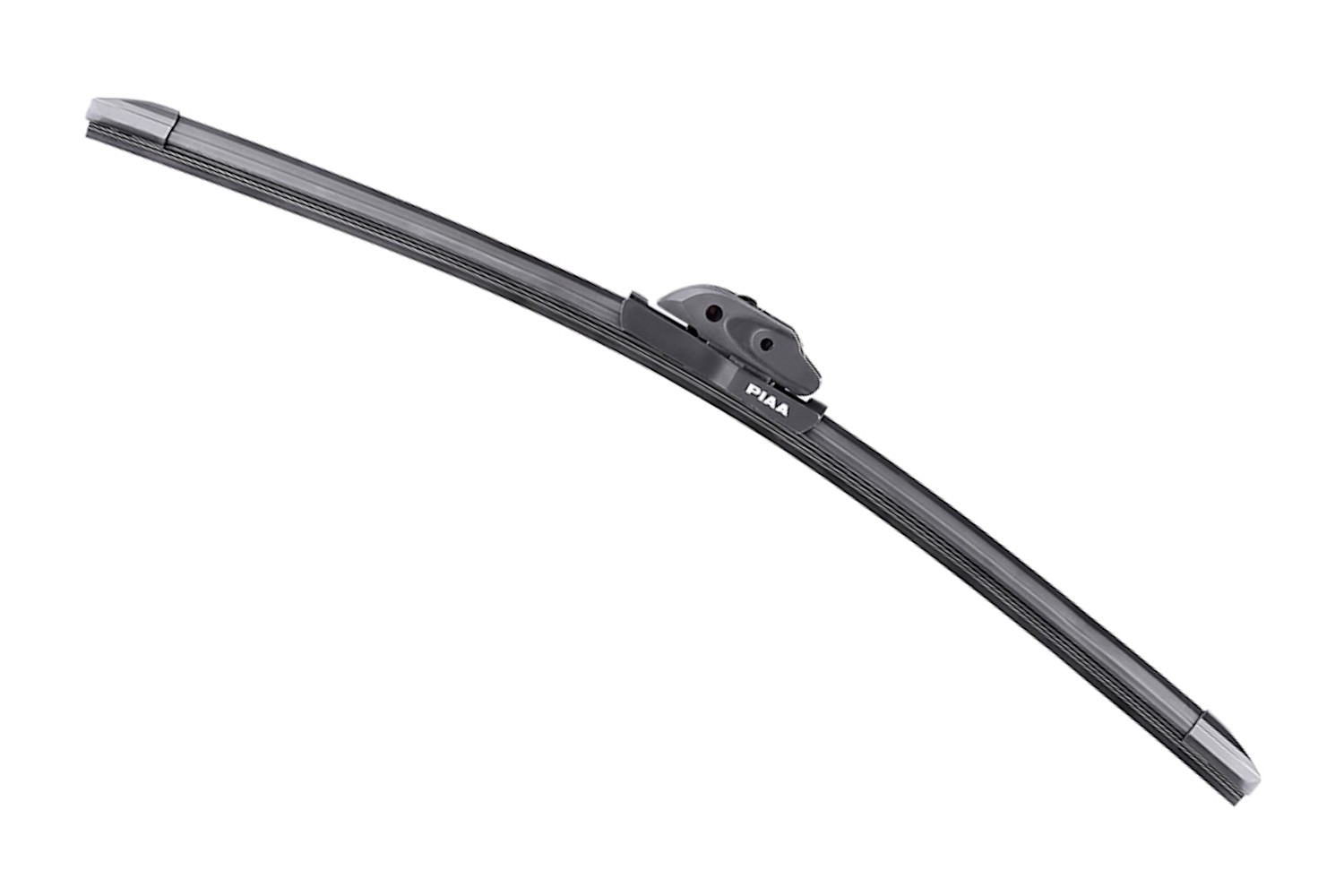 PIAA Si-Tech Windshield Wipers for best premium performance
PIAA Si-Tech Windshield Wipers for best premium performance
Rating: 9.2 / 10
Price: $36 per blade (Approx.)
Key Features:
- Wiper Style: Beam
- Blade Material: Silicone
- Available Lengths: 14-28 inches
- Attachment Types: J-hook, push-button arm, side-pin, bayonet, pin & hook
Pros:
- Top-tier beam design and silicone wiper blade performance.
- Includes windshield prep wipes to maximize the water-repellent effect of the silicone.
- PIAA offers wiper refills, extending the lifespan of the wiper assembly.
- 1-year limited warranty for added peace of mind.
Cons:
- Higher price point, the most expensive in our main picks.
- Lacks a locking clasp mechanism.
The PIAA Si-Tech windshield wipers represent the pinnacle of performance and features, justifying their premium price. As mentioned earlier, these wipers appear to be virtually identical to the Rain-X Silicone Endura in terms of construction and design, but with added extras that elevate them to the top of our premium category.
One key differentiator is the inclusion of windshield preparation wipes with the Si-Tech wipers. These wipes contain an alcohol cleaner and liquid silicone, designed to prep the windshield surface for optimal silicone wiper performance and enhance the initial water-repellent coating. While you could achieve a similar effect with aftermarket Rain-X treatment, the inclusion of prep wipes with the PIAA Si-Techs provides a convenient and integrated approach to maximizing water repellency.
Another significant advantage is that PIAA offers silicone wiper refills for the Si-Tech blades. This allows you to replace only the worn wiper element, rather than the entire blade assembly, extending the life of your investment and reducing waste. The beam design of the Si-Tech wipers is on par with the best from Rain-X and Bosch, delivering streak-free wiping and minimal noise. While they are the spendiest option, the PIAA Si-Tech wipers offer unmatched turn-key performance and long-term value, especially for those who prioritize ultimate visibility and durability.
Best Winter Windshield Wipers: Anco Winter Wiper
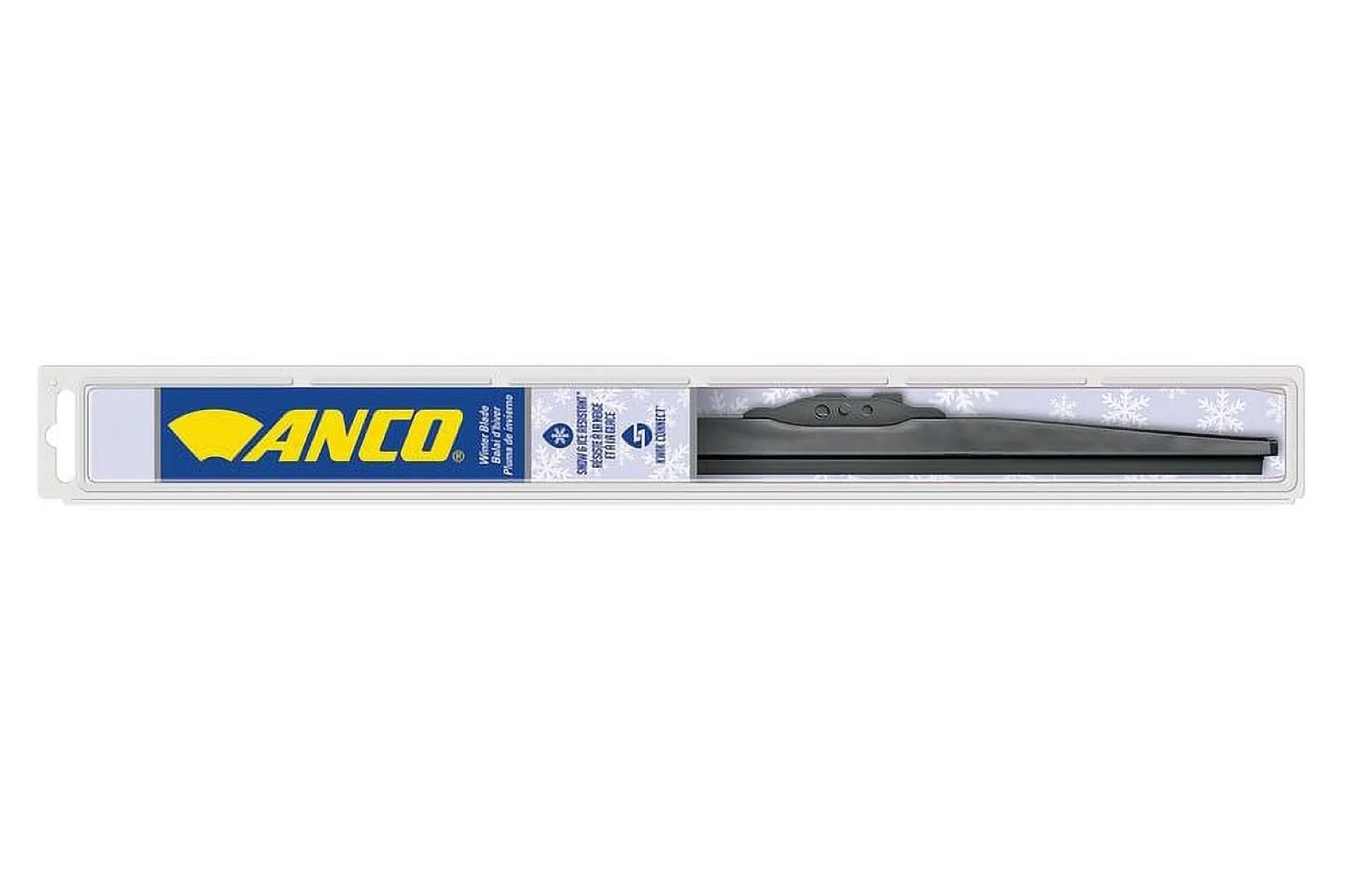 Anco Winter Wiper Windshield Wipers for best winter performance
Anco Winter Wiper Windshield Wipers for best winter performance
Rating: 7.0 / 10
Price: $25 per blade (Approx.)
Key Features:
- Wiper Style: Branch
- Blade Material: Rubber
- Available Lengths: 11-24 inches
- Attachment Types: J-hook, side pin, small and large bayonet styles
Pros:
- Full rubber encasement protects the wiper from snow and ice buildup.
- Rubber wiper element performs well in very low temperatures and resists tearing from ice.
- Affordable price point for seasonal winter use.
Cons:
- Wiping performance in standard rain conditions is not as refined as other top picks.
- Wiper arm mount design could be more robust.
The Anco Winter Wiper blades are specifically designed to tackle the harsh conditions of winter driving. While silicone beam wipers like the Bosch Icons perform admirably in winter, they can also take a beating from ice and snow. The Anco Winter Wipers are designed to be more sacrificial and better suited for extreme winter conditions, making them our top recommendation for winter wiper blades.
The key feature of these branch-style wipers is a thick rubber sleeve that fully encases the blade frame. This sleeve prevents snow and ice from accumulating within the wiper structure, a common problem with traditional branch wipers that can lead to chattering and ineffective wiping in winter. The wiper element itself is made of rubber, which is less prone to tearing when dragged across icy windshields compared to silicone, especially when dealing with unscraped windshields.
While their water-clearing performance might not be as refined as our top picks for general use, the Anco Winter Wipers are more than adequate for winter conditions, especially when combined with a windshield treatment like Rain-X. The connection point is versatile, fitting hook, side-pin, and bayonet-style wiper arms. The Anco Winter Wipers are an affordable and practical solution for maintaining clear visibility during winter driving, and we recommend swapping them in seasonally, like snow tires, to protect your primary wiper blades and ensure optimal winter performance.
Other Notable Windshield Wiper Options
Beyond our top picks, several other windshield wipers are worth considering, depending on specific needs and preferences.
Trico Silicone Ceramic
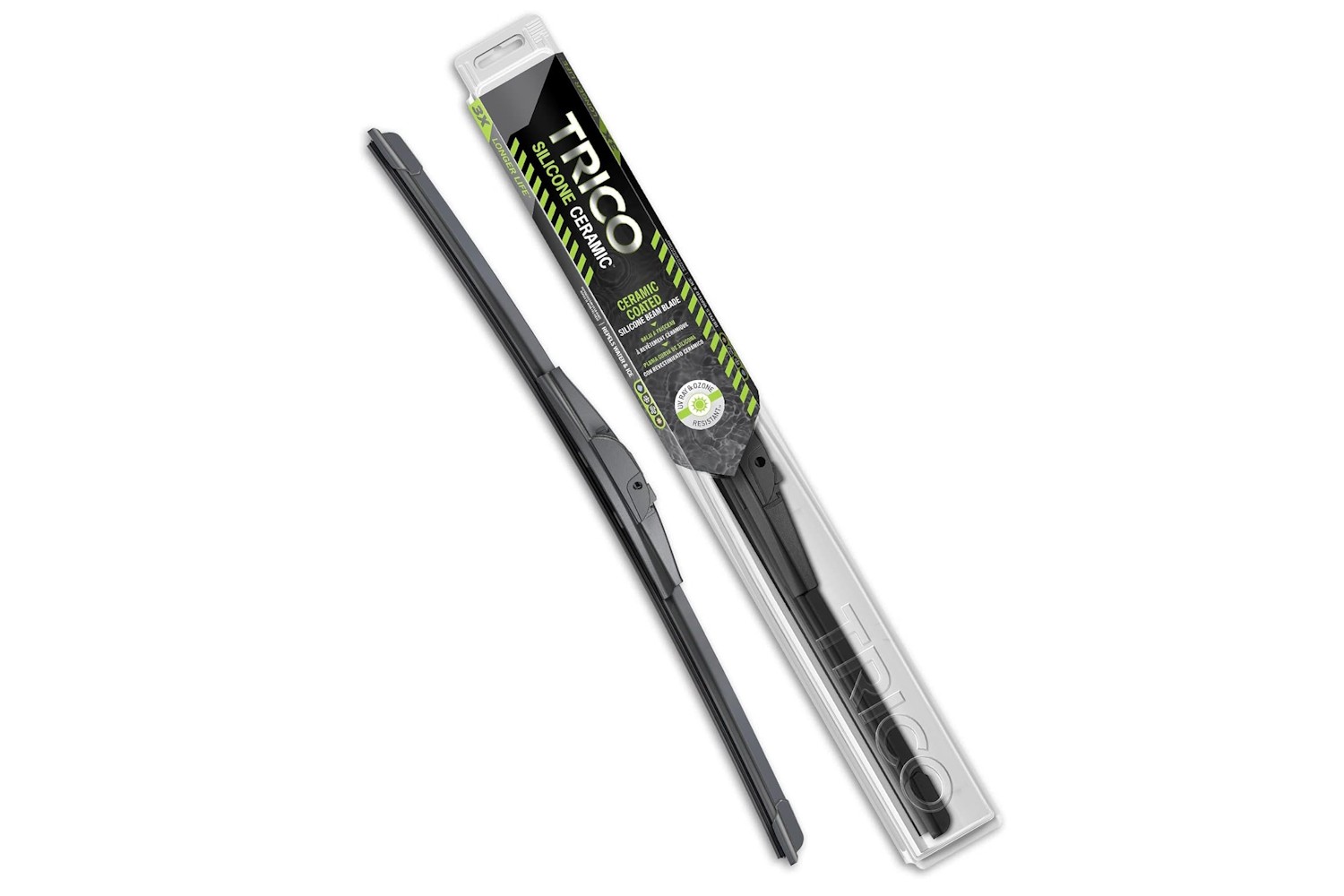 Trico Silicone Ceramic Windshield Wipers as a notable alternative option
Trico Silicone Ceramic Windshield Wipers as a notable alternative option
Rating: 7.1 / 10
Price: $36 per blade (Approx.)
Key Features:
- Wiper Style: Beam
- Blade Material: Silicone with Ceramic Coating
- Available Lengths: 14-28 inches
- Attachment Types: J-hook, push button, side-pin, pinch-tab
Pros:
- Aerodynamic design with integrated spoiler.
- Ceramic coating on silicone blades reduces friction and enhances durability.
- Excellent contact across the windshield for thorough wiping.
Cons:
- One of the more expensive options.
- Broad attachment base may limit flexibility slightly.
The Trico Silicone Ceramic wiper blades are a premium option packed with advanced features. Their higher price tag reflects the sophisticated chemistry incorporated into these blades, particularly the ceramic coating on the silicone wiper element. This ceramic coating is designed to minimize friction, promoting smoother and quieter operation while extending the lifespan of the blades.
Performance-wise, the Trico Silicone Ceramics are comparable to the PIAA Si-Tech and Rain-X Silicone Endura, delivering excellent water clearing and streak-free wiping. The aerodynamic design, complete with an integrated spoiler, is intended to enhance wiper contact at higher speeds, although its real-world downforce contribution is debatable. However, the contact across the windshield is indeed excellent, and we observed no high-speed shuddering in our tests.
Choosing between the Trico Silicone Ceramics and the PIAA Si-Techs is a close call. We slightly favor the PIAA for its more aggressive blade curvature and included windshield prep wipes. However, the Trico’s ceramic coating may offer a potential edge in long-term performance and durability, making them a worthy alternative in the premium category.
Rain-X Latitude Water Repellency
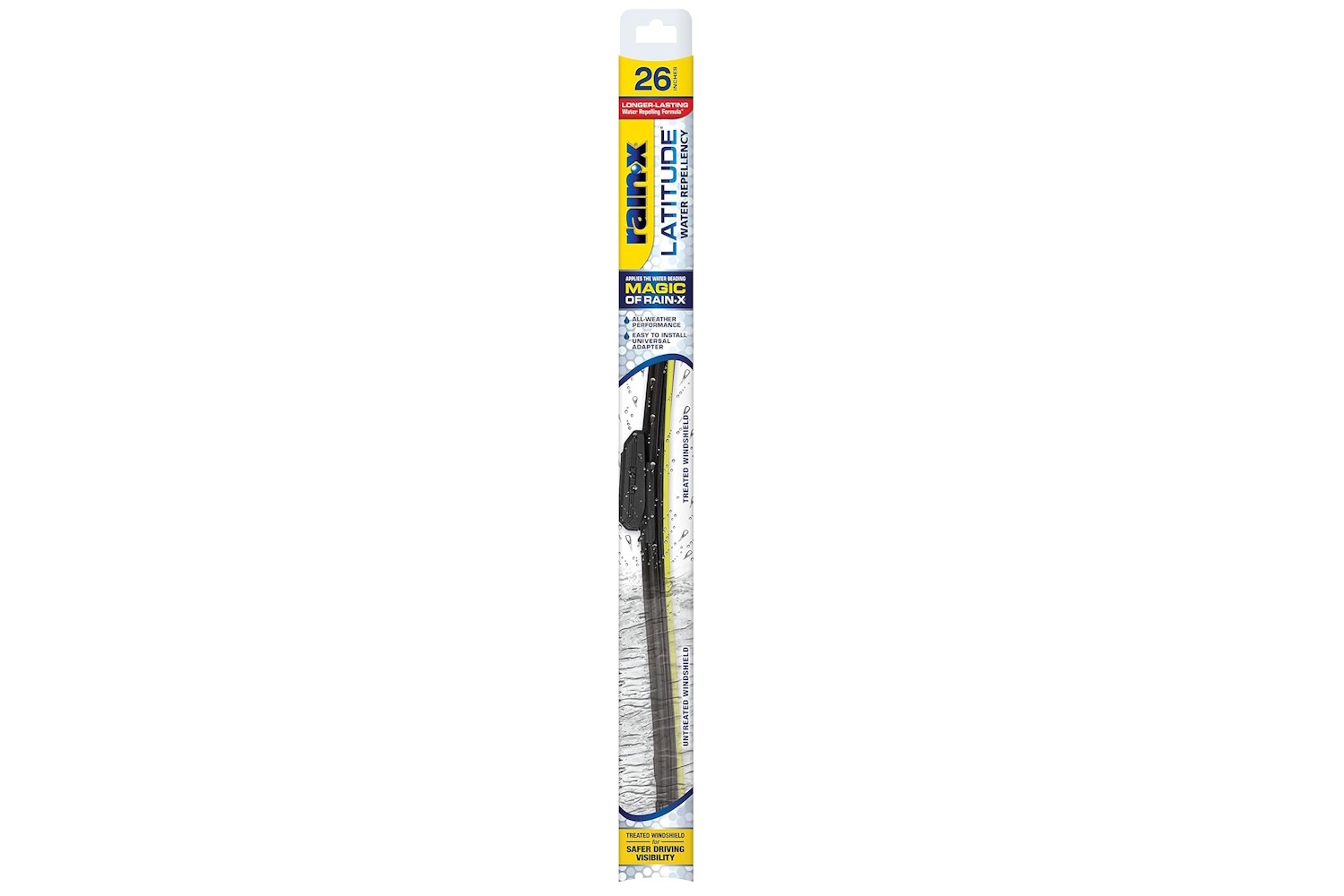 Rain-X Latitude Water Repellency Windshield Wipers as a notable alternative option
Rain-X Latitude Water Repellency Windshield Wipers as a notable alternative option
Rating: 7.3 / 10
Price: $18 per blade (Approx.)
Key Features:
- Wiper Style: Beam
- Blade Material: Rubber with Rain-X Coating
- Available Lengths: 14-28 inches
- Attachment Types: J-hooks, pinch-tab, pin-arms, pinch-tab button
Pros:
- Rain-X silicone coating on rubber blades enhances smooth operation and water repellency.
- Well-curved beam design for good windshield contact.
- Quiet operation, even at higher wiper speeds.
Cons:
- Rain-X coating longevity is limited compared to silicone blades.
- Bulkier attachment mount compared to some competitors.
The Rain-X Latitude Water Repellency wipers occupy a solid mid-tier position, offering a good balance of performance and price. These beam-style wipers utilize rubber blades infused with a Rain-X silicone coating. This coating provides an initial boost in water repellency, causing water to bead and run off the windshield, similar to dedicated Rain-X treatments.
While the Rain-X Latitude doesn’t offer the long-term water-repellent benefits of full silicone blades, the coating does improve wiping performance and reduces friction, making them quieter in operation than typical rubber wipers. In our tests, the Rain-X coating lasted for a good portion of a driving season in the Pacific Northwest. The beam design is similar to the premium Rain-X Silicone Endura, with a slightly more aggressive curve that aids in maintaining windshield contact at higher speeds.
The attachment mount is a bit bulkier than some other beam wipers, which may slightly increase wind resistance. However, at around $18 per blade, the Latitude Water Repellency wipers are an excellent value proposition in the mid-range category. Pairing them with Rain-X washer fluid additive can further extend the water-repellent effect and maintain clear visibility throughout the year without the higher cost of full silicone blades.
Trico Flex
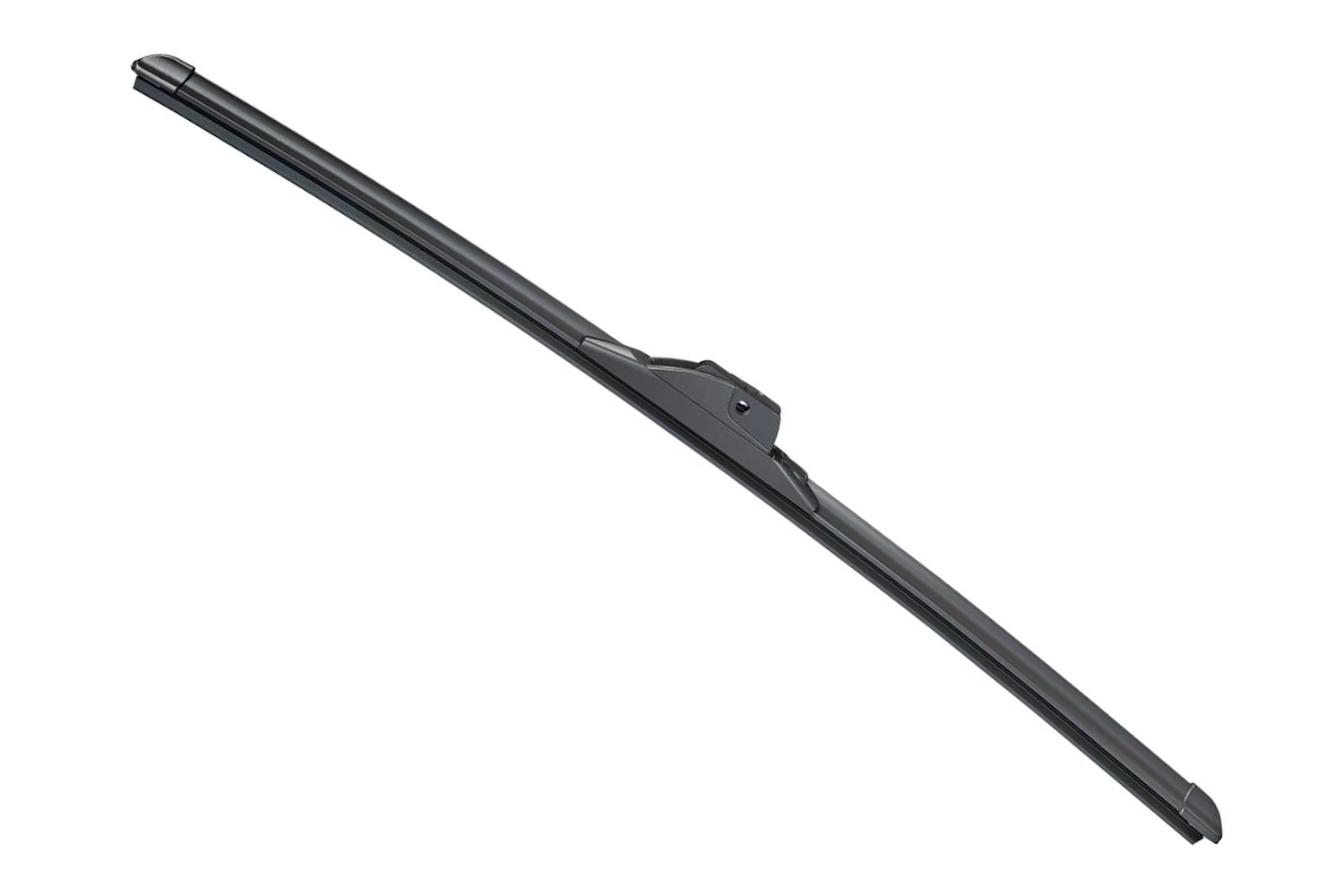 Trico Flex Windshield Wipers as a notable alternative option
Trico Flex Windshield Wipers as a notable alternative option
Rating: 6.9 / 10
Price: $17 per blade (Approx.)
Key Features:
- Wiper Style: Beam
- Blade Material: Rubber
- Available Lengths: 13-32 inches
- Attachment Types: J-hook, pinch-tab, side-pin, push-button, side-lock, bayonet
Pros:
- Budget-friendly pricing.
- Solid beam design for consistent windshield contact.
- Wide range of available lengths to fit various vehicles.
Cons:
- Slight streaking observed during testing.
- Plastic frame may feel less robust and has a less aggressive curve compared to premium wipers.
- Attachment compatibility is not as broad as some competitors.
The Trico Flex wiper blades are a strong contender in the budget category, offering beam-style performance at an affordable price. While they utilize a more economical rubber wiper element, the beam design itself is well-executed, providing good water removal with only minor streaking in our tests.
Compared to the Bosch Icons, the Trico Flex offers very similar performance, with the main difference being the Bosch’s superior attachment mechanism. The Trico Flex blades may feel slightly less premium in hand, with a lighter-duty plastic frame and mount. The blade curvature is also less aggressive than some higher-end beam wipers.
However, for the price, the Trico Flex blades deliver excellent value. They are a dependable option for drivers who don’t require top-of-the-line performance or live in areas with infrequent rainfall. If you are seeking a budget-friendly beam-style wiper that gets the job done effectively, the Trico Flex is a solid choice.
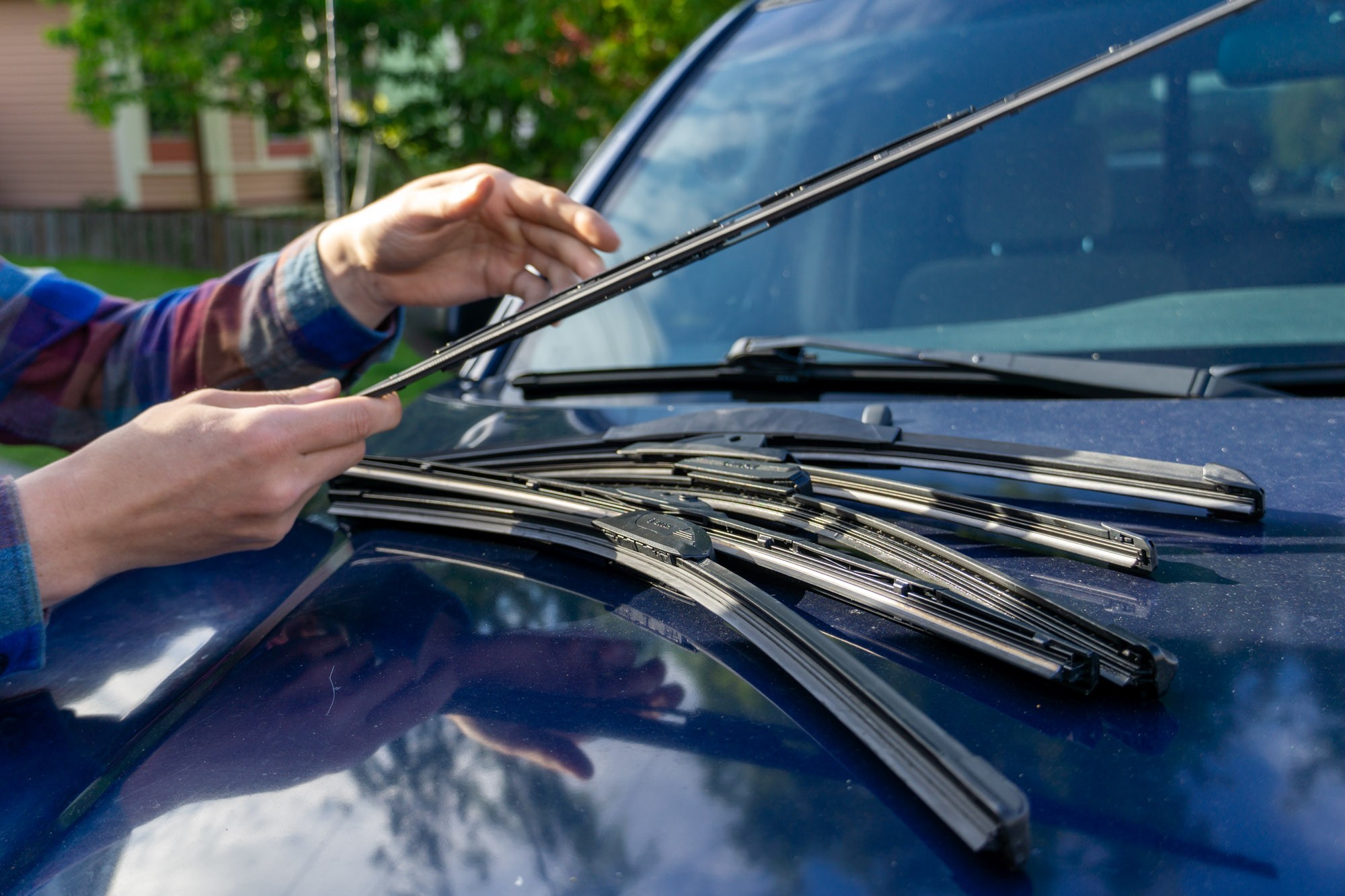 A selection of different wiper blades prepared for testing and comparison
A selection of different wiper blades prepared for testing and comparison
Windshield Wiper Comparison Chart
| Windshield Wipers | Price (Per Wiper) | Wiper Style | Blade Material | Available Lengths |
|---|---|---|---|---|
| Rain-X Silicone Endura | $26 | Beam | Silicone | 14-28” |
| AERO Voyager J-Hook | $8 (per set) | Beam | Rubber | 13-28” |
| SilBlade Standard | $26 | Branch | Silicone | 11-28” |
| Bosch Icon | $30 | Beam | Rubber | 13-28” |
| PIAA Si-Tech | $36 | Beam | Silicone | 14-28” |
| Anco Winter Wiper | $25 | Branch | Rubber | 11-24” |
| Trico Silicone Ceramic | $36 | Beam | Silicone | 14-28” |
| Rain-X Latitude Water Repellency | $18 | Beam | Rubber | 14-28” |
| Trico Flex | $17 | Beam | Rubber | 13-32” |
How We Rigorously Tested the Best Windshield Wipers
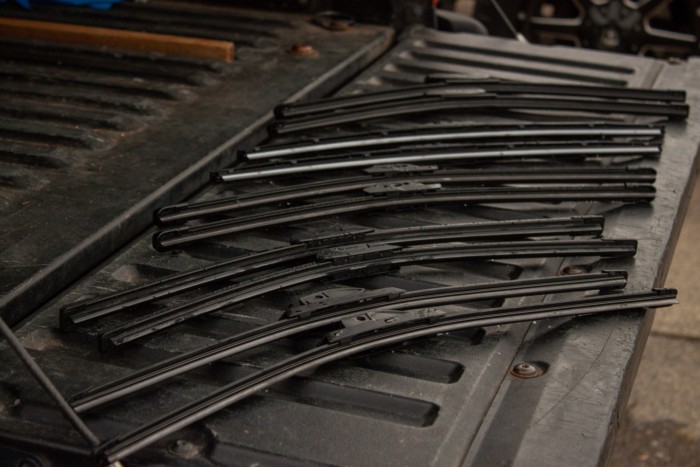 Windshield wiper blades prepared for testing on a truck tailgate
Windshield wiper blades prepared for testing on a truck tailgate
To ensure our windshield wiper recommendations are based on real-world performance, we conducted thorough testing, going beyond simple marketing claims. Our goal was to objectively assess each wiper’s ability to clear water, operate quietly, and install easily.
Our Detailed Testing Methodology and Location
Our testing process involved a combination of controlled lab-like conditions and real-world driving scenarios. We used a Toyota Tacoma as our test vehicle and created a controlled “rain” environment using sprinklers to simulate various rainfall intensities, from light drizzle to heavy downpours. A slow-motion camera and audio recorder were used to capture detailed performance data.
For each wiper blade set, we performed the following tests:
- Water Clearing Test: Wipers were operated at a consistent speed with a standardized amount of water spray. We assessed the amount of water cleared, streak-free performance, and any shuddering or skipping.
- Noise Level Test: Audio recordings were analyzed to measure the noise generated by each wiper blade during operation. Quieter wipers were rated higher.
- Installation and Removal Assessment: Multiple testers installed and removed each wiper set without consulting instructions to evaluate the ease of installation and the user-friendliness of the attachment mechanisms. We noted any difficulties or potential finger-pinching hazards.
- Real-World Driving Test: Beyond controlled testing, we drove vehicles equipped with the wipers in diverse weather conditions, including heavy rain on the Olympic Peninsula, snowstorms in British Columbia, and muddy trails, to assess real-world performance and durability.
- Durability and Longevity Monitoring: We continuously used the tested wipers on our vehicles over extended periods to track their long-term durability and performance degradation, updating our reviews with this data.
Our Expert Windshield Wiper Testers
Our lead tester, Nick Belcaster, residing in the rain-prone Pacific Northwest, has extensive experience with windshield wipers, necessitating frequent replacements and even wiper motor replacements due to heavy usage. His firsthand experience in challenging weather conditions, including mountain passes and unexpected storms, provides valuable insights into wiper blade performance under pressure.
Furthermore, our wiper testing benefits from the collective expertise of GearJunkie’s team of auto-savvy editors and contributors, who provide ongoing feedback and testing data from their own vehicles and driving experiences. This collaborative approach ensures our recommendations are well-rounded and reflect a broad range of real-world usage scenarios.
Buyer’s Guide: Choosing the Right Windshield Wipers for Your Needs
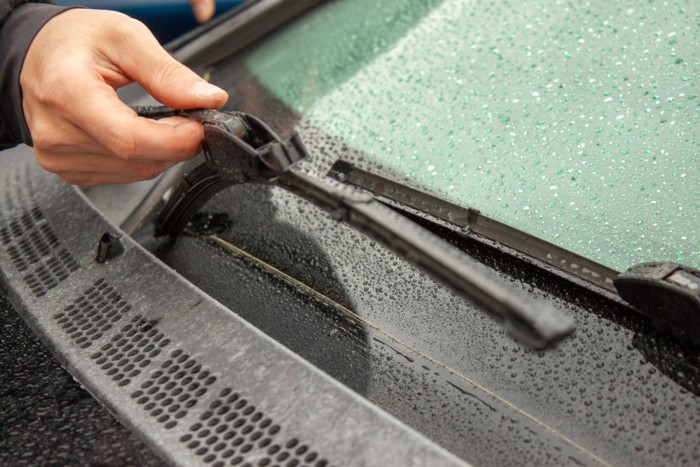 Lifting windshield wipers from a wet car window
Lifting windshield wipers from a wet car window
Selecting the best windshield wipers involves considering several factors beyond just price. Understanding the different types of wiper blades, materials, and features will help you make an informed decision and choose wipers that best suit your vehicle, driving conditions, and budget.
Windshield Wiper Blade Design: Understanding the Types
Windshield wiper blade design has evolved over the years, with key advancements focusing on improving windshield contact, reducing noise, and enhancing performance in various weather conditions. The primary design types are traditional branch frames, modern beam frames, and hybrid frames.
Traditional Branch Frames
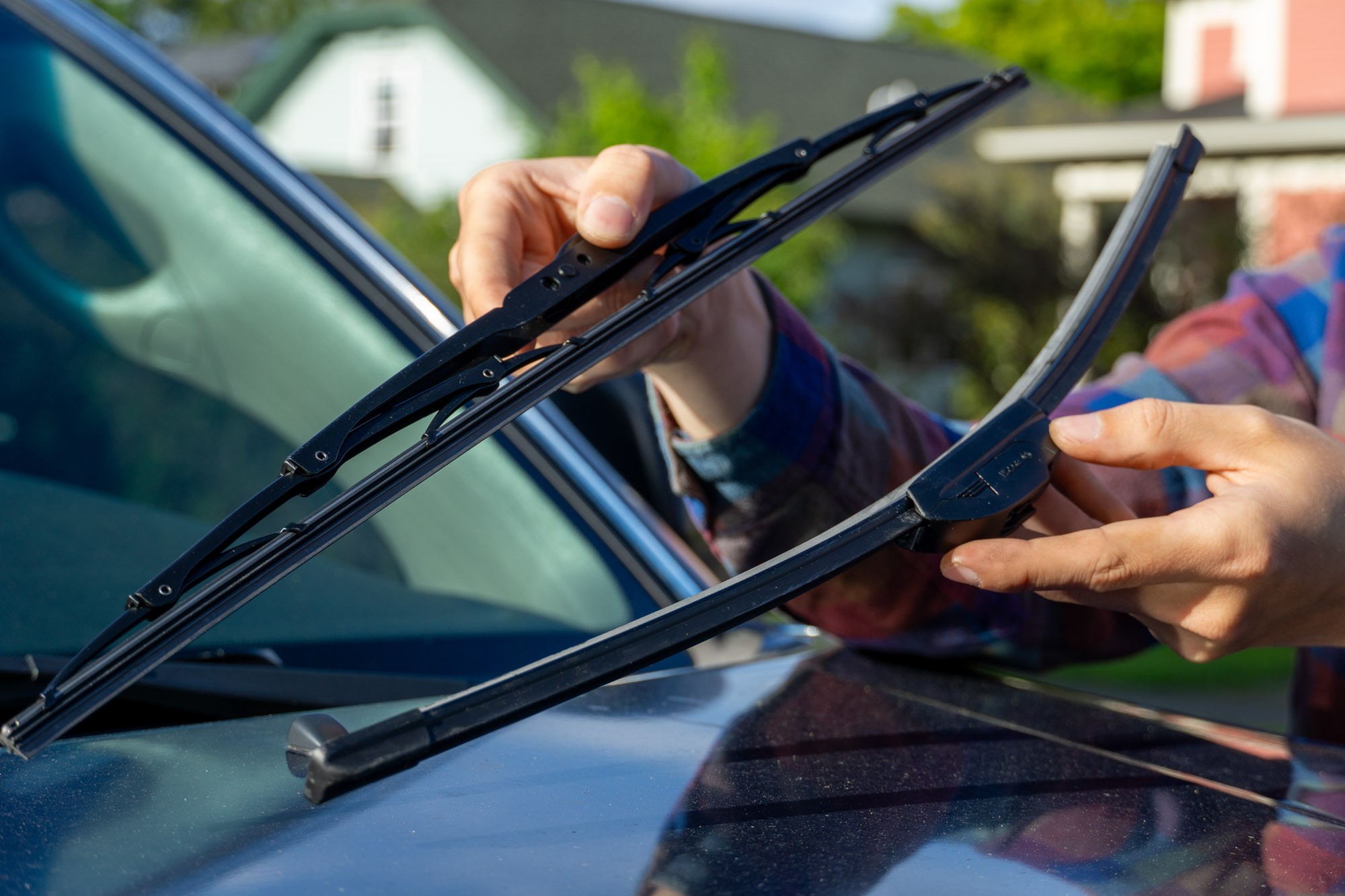 Branch style and beam style windshield wipers compared side-by-side
Branch style and beam style windshield wipers compared side-by-side
Branch-style wipers represent the older, more traditional design. They consist of a series of metal branches or arms that distribute pressure along the length of the wiper blade. While they can conform to curved windshields to some extent, they often lack consistent pressure distribution, potentially leading to uneven wiping and streaking. The metal frames are typically made of steel and may be susceptible to rust over time, especially in harsh climates.
In snowy and icy conditions, branch-style wipers are prone to ice buildup between the branches, which can hinder their flexibility and cause chattering or skipping across the windshield. However, for drivers in drier regions or for rear windshield wipers where performance demands are lower, branch-style wipers like the SilBlade Standards or PIAA Super Silicones can be a cost-effective option.
Beam Frames
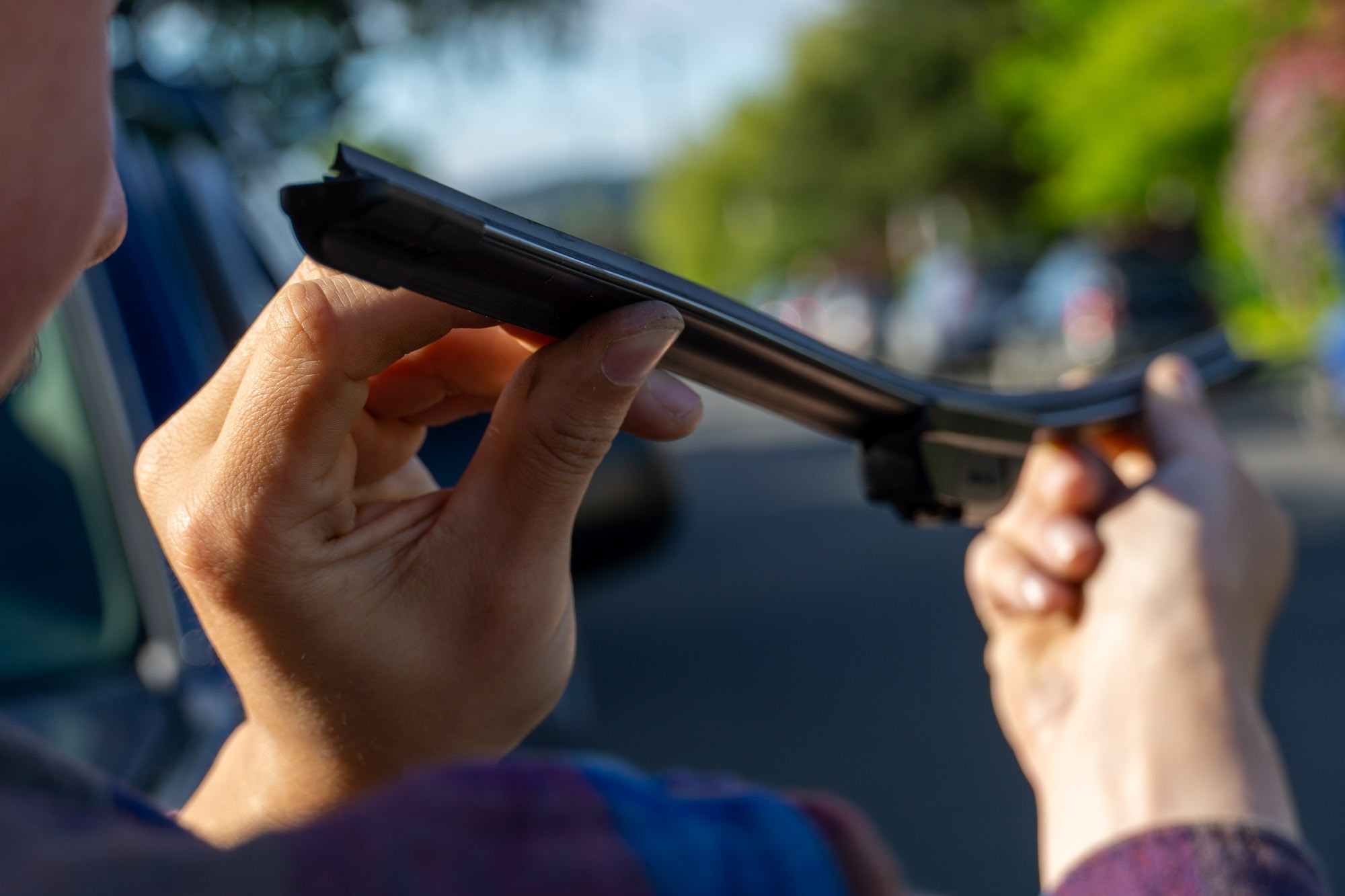 Curvature detail of a beam-style windshield wiper blade
Curvature detail of a beam-style windshield wiper blade
Beam-style wiper blades represent a modern advancement in wiper design. They feature a one-piece or two-piece frame design with integrated tension bands that apply even pressure across the entire length of the wiper blade. This consistent pressure distribution results in superior windshield contact, leading to more efficient and streak-free wiping compared to branch-style wipers.
Beam wipers are generally constructed with higher-quality materials and exhibit less chatter and noise during operation. Their aerodynamic profile also reduces wind lift and noise, especially at highway speeds. The Bosch Icons exemplify the perfected beam-style design, offering exceptional flexibility and consistent windshield contact.
Hybrid Frames
Hybrid wiper blades attempt to combine the benefits of both branch and beam designs. They typically utilize a branch-style frame but incorporate an aerodynamic outer cover. This cover helps to reduce wind lift and minimize ice buildup, addressing some of the shortcomings of traditional branch-style wipers. Hybrid wipers offer a compromise between the cost-effectiveness of branch wipers and the performance advantages of beam wipers.
Wiper Performance: Key Factors to Consider
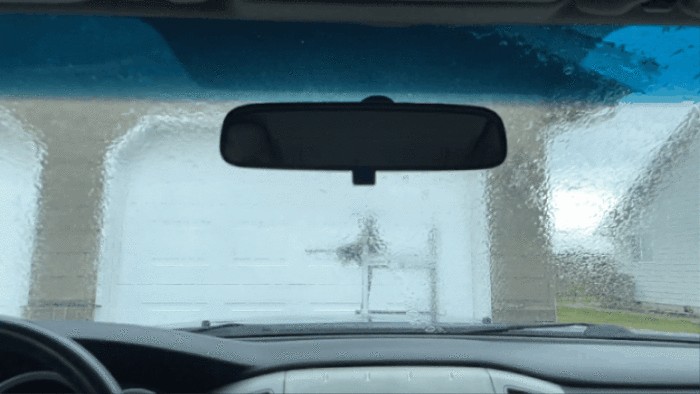 Animated GIF showing windshield wiper performance during testing
Animated GIF showing windshield wiper performance during testing
Wiper performance is determined by several factors, including blade design, material, and coating. When evaluating wiper performance, consider the following:
- Streak-Free Wiping: The primary function of wiper blades is to clear the windshield without leaving streaks or smears that can impair visibility. High-quality wipers should provide a clean, streak-free wipe across the entire windshield.
- Water Removal Efficiency: Effective wipers should quickly and efficiently remove water from the windshield, even in heavy rain. Look for wipers that clear water completely on the first pass, minimizing the need for multiple wipes.
- Noise Level: Noisy wipers can be distracting and irritating. Opt for wipers that operate quietly without squeaking, chattering, or shuddering.
- Windshield Contact: Consistent contact between the wiper blade and the windshield is crucial for effective wiping. Beam-style wipers generally offer superior contact compared to branch-style wipers, especially on curved windshields.
- Durability and Longevity: Choose wipers made from durable materials that can withstand exposure to UV radiation, ozone, temperature extremes, and road debris. Silicone blades typically outlast rubber blades in terms of durability.
Wiper Blade Materials: Rubber vs. Silicone
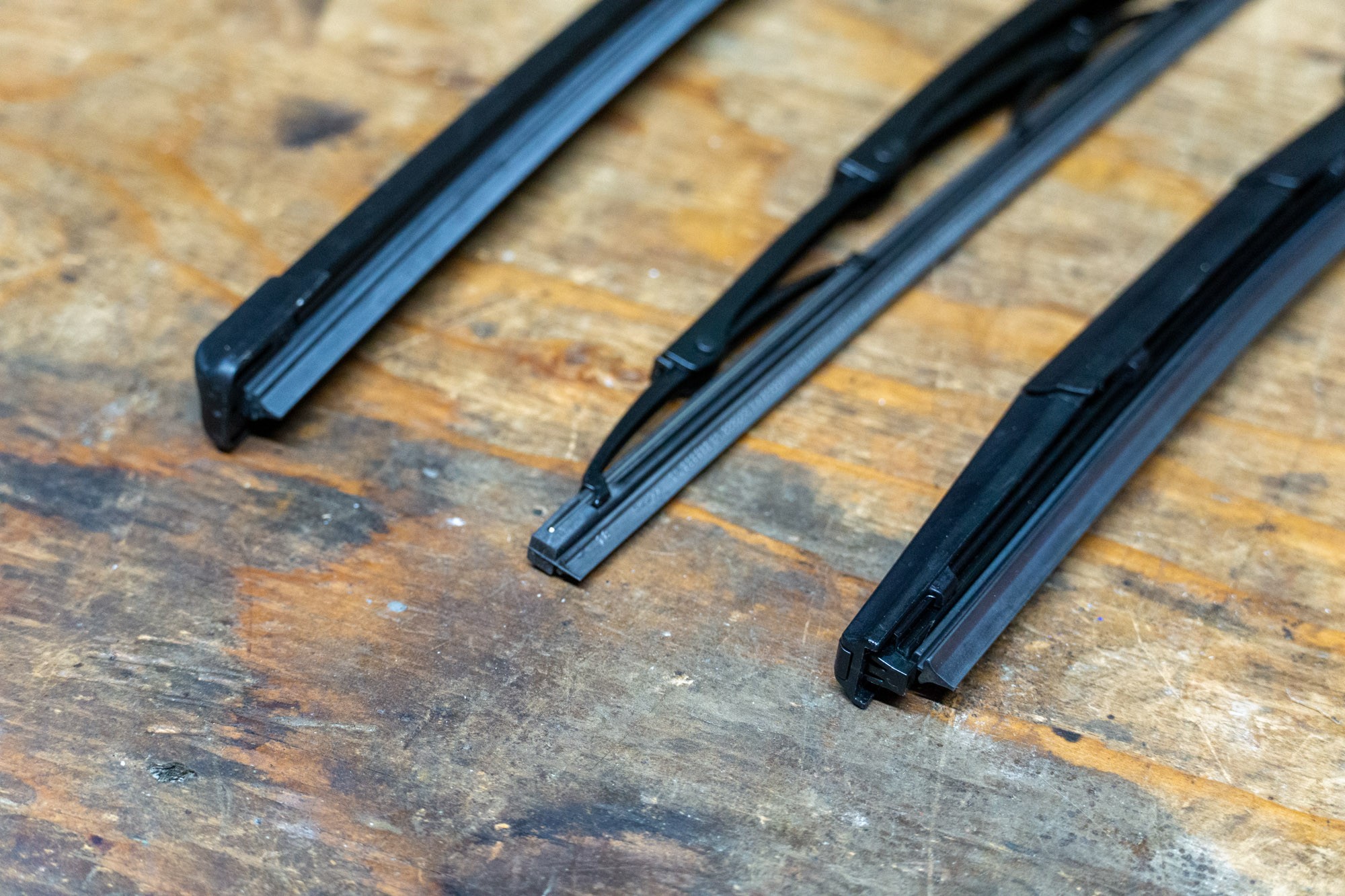 Close-up of different wiper blade materials and styles
Close-up of different wiper blade materials and styles
The material of the wiper blade element, the part that contacts the windshield, significantly impacts wiper performance and longevity. The two primary materials are rubber and silicone.
Rubber Blades
Rubber has been the traditional wiper blade material for decades. Natural rubber blades offer good wiping performance when new and properly maintained. However, rubber is susceptible to degradation from UV radiation, ozone, and temperature fluctuations, which can cause them to harden, crack, and lose their effectiveness over time. Dirty windshields and debris can also accelerate the wear and tear of rubber blades.
Silicone Blades
Silicone wiper blades are a more recent advancement, offering several advantages over rubber. Silicone is significantly more resistant to environmental degradation, including UV radiation, ozone, and temperature extremes. As a result, silicone blades typically last much longer than rubber blades and maintain their performance over an extended period.
Furthermore, silicone blades often incorporate a water-repellent property. With each wipe, they deposit a thin layer of silicone onto the windshield, creating a hydrophobic coating that causes water to bead and roll off. This water-repellent effect enhances visibility in rain and reduces the reliance on wiper operation. Wipers like the Rain-X Silicone Endura and PIAA Si-Tech exemplify the superior performance of silicone blades.
Coated Blades
Both rubber and silicone blades can be enhanced with coatings to improve performance and durability. Common coatings include Teflon and graphite, which reduce friction, promote smoother wiping, and extend blade life. These coatings create a slick surface that allows the blade to glide more easily across the windshield, reducing noise and wear. However, these coatings are not permanent and will gradually wear off over time. The graphite coating on Rain-X Latitudes and the ceramic coating on Trico Silicone Ceramics are examples of performance-enhancing coatings.
Wiper Blade Mounting and Attachment Types
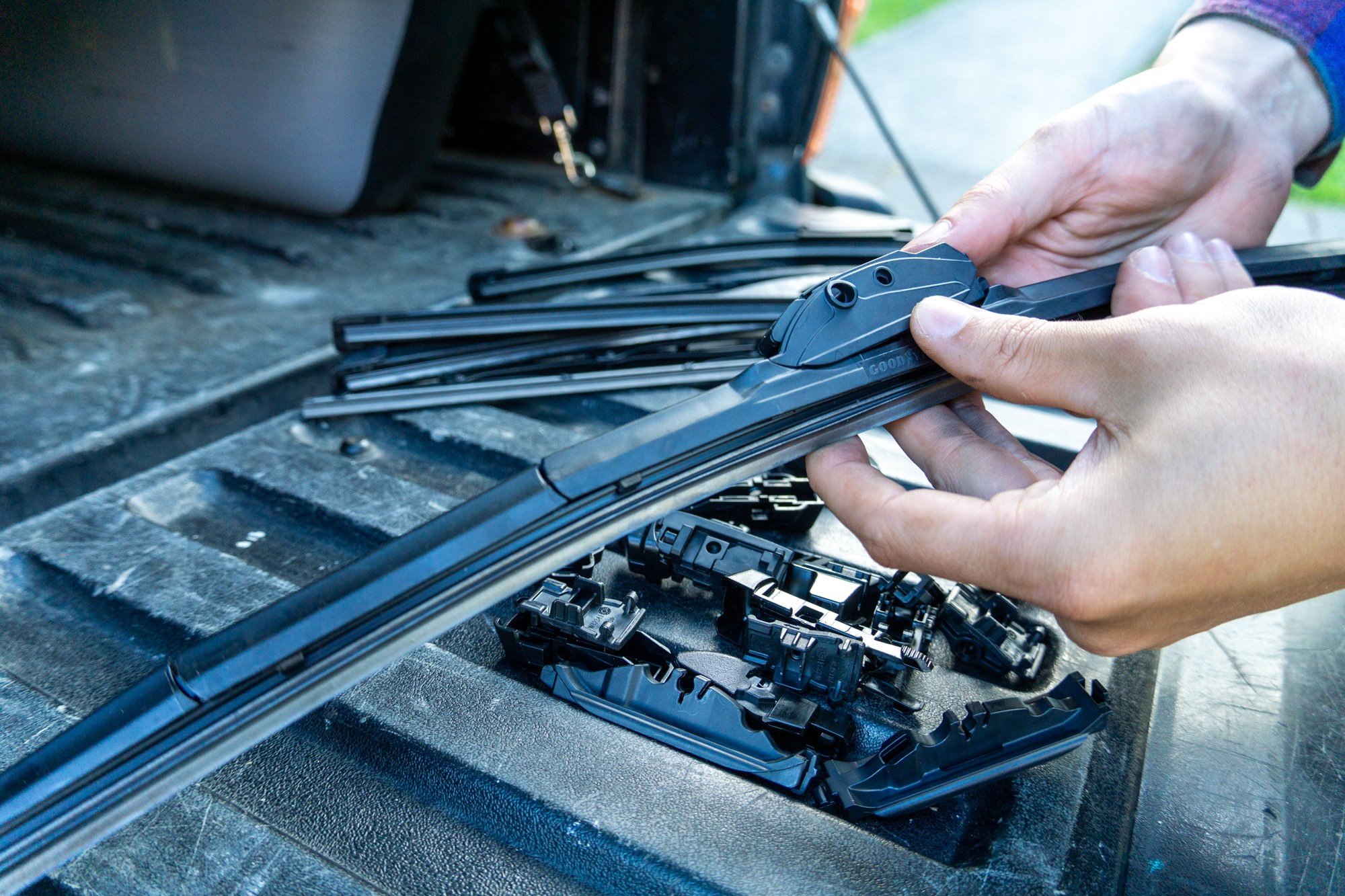 Hands swapping out windshield wiper blade mounts
Hands swapping out windshield wiper blade mounts
Windshield wiper arms utilize various attachment mechanisms to connect to wiper blades. The most common attachment type is the J-hook, but other types include side pins, bayonets, and push-button mounts. Wiper blade manufacturers often include multiple adapters with their blades to ensure compatibility with a wide range of vehicle attachment types.
To ensure you purchase the correct wiper blades for your vehicle, consult your vehicle’s owner’s manual or use online wiper blade lookup tools that allow you to enter your vehicle’s make, model, and year to identify the correct blade size and attachment type. Alternatively, you can visit an auto parts store, where staff can assist you in selecting the right wipers.
“Exact fit” wiper blades are also available, designed specifically to match the original equipment (OE) specifications of your vehicle. These blades typically do not include adapters and offer a simplified installation process, ensuring a direct and secure fit for your specific vehicle.
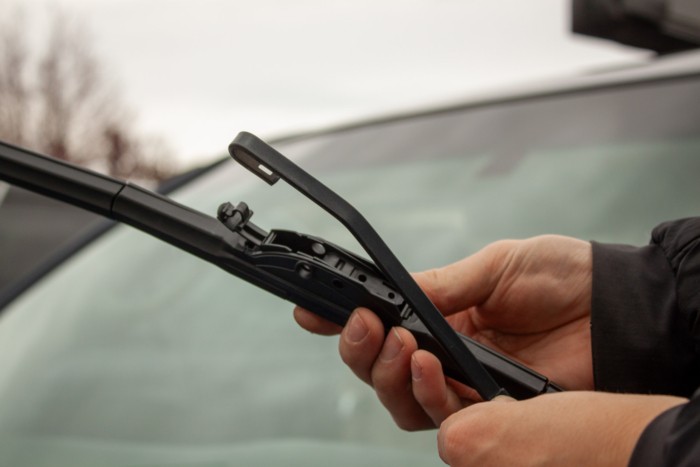 Hands attaching a new windshield wiper blade to the wiper arm
Hands attaching a new windshield wiper blade to the wiper arm
Durability and Replacement Frequency of Wiper Blades
Even the best windshield wipers will eventually wear out and require replacement. Regularly replacing your wiper blades is essential for maintaining optimal visibility and driving safety. As part of your routine vehicle maintenance, inspect your wiper blades and replace them when necessary.
The typical lifespan of wiper blades is around 6 months to a year, but this can vary depending on usage frequency, driving conditions, and blade material quality. High-end silicone blades may last longer than rubber blades.
Signs that indicate it’s time to replace your wiper blades include:
- Streaking or Smearing: Wipers leave noticeable streaks or smears on the windshield.
- Skipping or Chattering: Wipers skip or chatter across the windshield surface instead of wiping smoothly.
- Squeaking or Screeching: Wipers make loud squeaking or screeching noises during operation.
- Visible Damage: The wiper blade element is visibly cracked, torn, or damaged.
- Reduced Water Clearing Efficiency: Wipers no longer clear water effectively, even in light rain.
Regularly cleaning your windshield and wiper blades can help prolong their lifespan and maintain optimal performance. Use windshield washer fluid and a soft cloth to remove dirt, debris, and bug residue from the windshield and wiper blades.
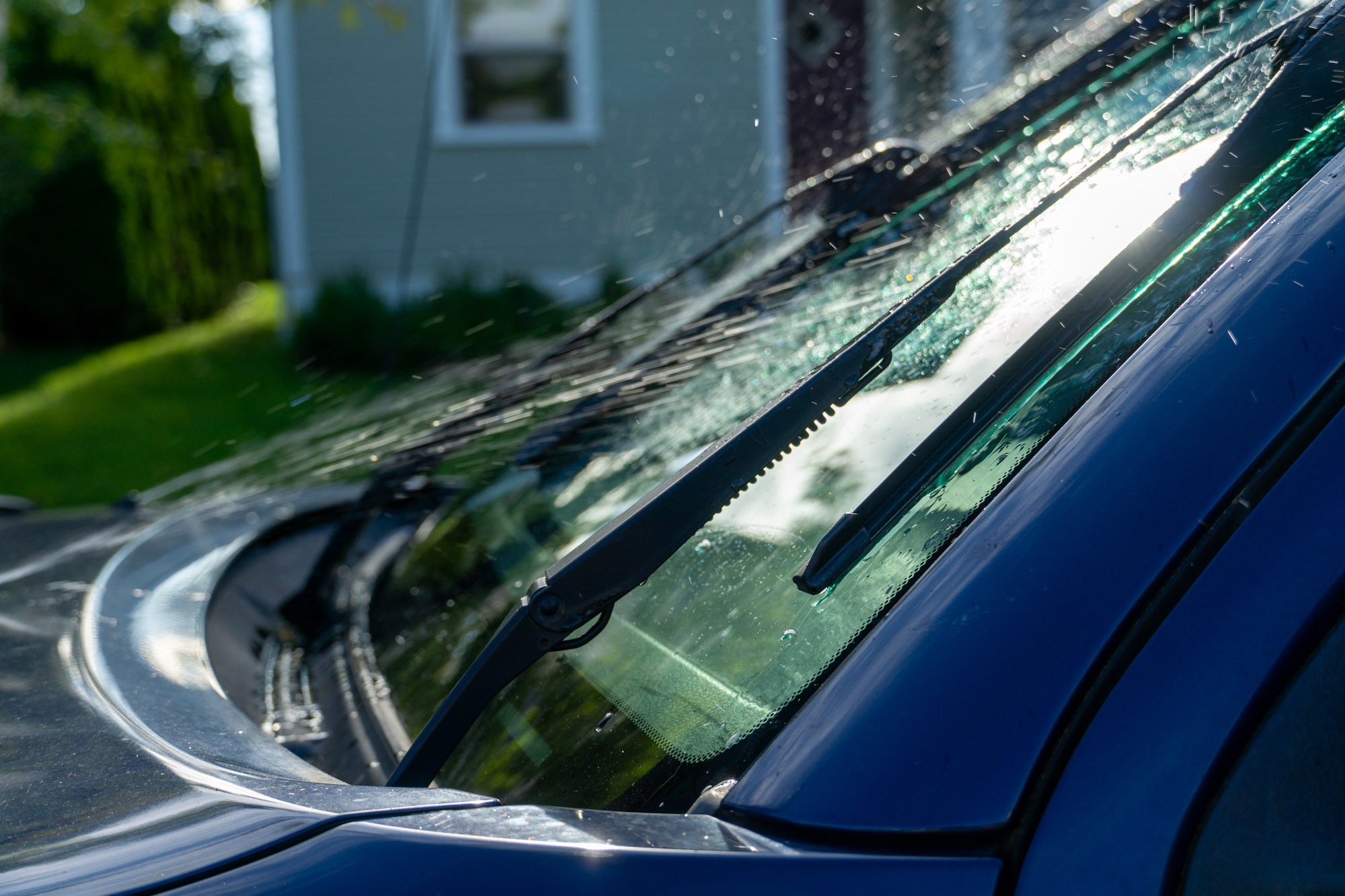 Windshield wipers operating with washer fluid spray
Windshield wipers operating with washer fluid spray
Price and Value Considerations for Windshield Wipers
The price of windshield wipers varies depending on the type, material, brand, and features. Consider your budget and driving needs when choosing wiper blades.
Budget-Friendly Wiper Options
If you live in a drier climate or are outfitting a vehicle used primarily in fair weather, budget-friendly wiper blades can be a suitable option. These are typically rubber branch-style blades that offer basic performance at a lower cost. The AERO Voyager J-Hook set provides an upgrade to beam-style design within the budget category.
Mid-Range Wiper Options
Mid-tier wiper blades offer a balance of performance and price. These often include beam-style designs and may utilize coated rubber or basic silicone blades. The Rain-X Silicone Endura and Bosch Icon are excellent choices in this category, offering enhanced performance without the premium price tag.
Premium Wiper Options
Premium wiper blades represent the top tier in terms of performance and features. These are typically beam-style wipers made with high-quality silicone blades and advanced features like water-repellent coatings or windshield prep wipes. The PIAA Si-Tech and Trico Silicone Ceramic are examples of premium wipers that offer ultimate performance and durability, justifying their higher price for drivers who prioritize maximum visibility and longevity, especially in demanding driving conditions.
Frequently Asked Questions About Windshield Wipers
What are the best-rated windshield wipers overall?
The Rain-X Silicone Endura wiper blades are our top recommendation for best overall performance. Their silicone blades offer superior water clearing, long-lasting durability, and a built-in water-repellent effect. For a slightly higher price, the PIAA Si-Tech wipers offer similar performance with the added benefit of windshield prep wipes.
Do expensive windshield wipers really make a difference?
While extremely expensive wipers might not offer a drastically significant performance increase, very cheap wipers will likely result in noticeably poorer performance. Investing in mid-range to premium wipers like the Bosch Icon or Rain-X Latitude will provide a tangible improvement in wiping quality, durability, and overall visibility compared to basic budget wipers. The added cost translates to better materials, designs, and features that enhance driving safety and comfort.
Which windshield wipers are known to last the longest?
Silicone wiper blades are generally more durable and longer-lasting than rubber blades due to their resistance to environmental degradation. Beam-style designs also tend to outlast branch-style wipers due to their robust construction and fewer moving parts. For maximum longevity, consider silicone beam wipers like the PIAA Si-Tech, which are made from high-quality materials and even offer wiper refills to further extend their lifespan.
What is the average lifespan of a windshield wiper blade?
The average windshield wiper blade lasts for approximately one year under normal driving conditions. However, with regular windshield cleaning and in less demanding climates, some wipers, especially high-end silicone models, can last longer. Replace your wipers as soon as you notice signs of wear, such as streaking, noise, or reduced water clearing efficiency.
Are silicone wiper blades truly better than traditional rubber blades?
For most drivers seeking optimal performance across diverse weather conditions, silicone wiper blades are generally superior to rubber blades. They offer smoother, streak-free wiping, enhanced water repellency, and significantly longer lifespan. However, in extremely cold and icy climates, rubber blades may have a slight advantage as silicone can become too soft and potentially tear when encountering heavy ice buildup. For overall performance and longevity, silicone is generally the preferred choice.
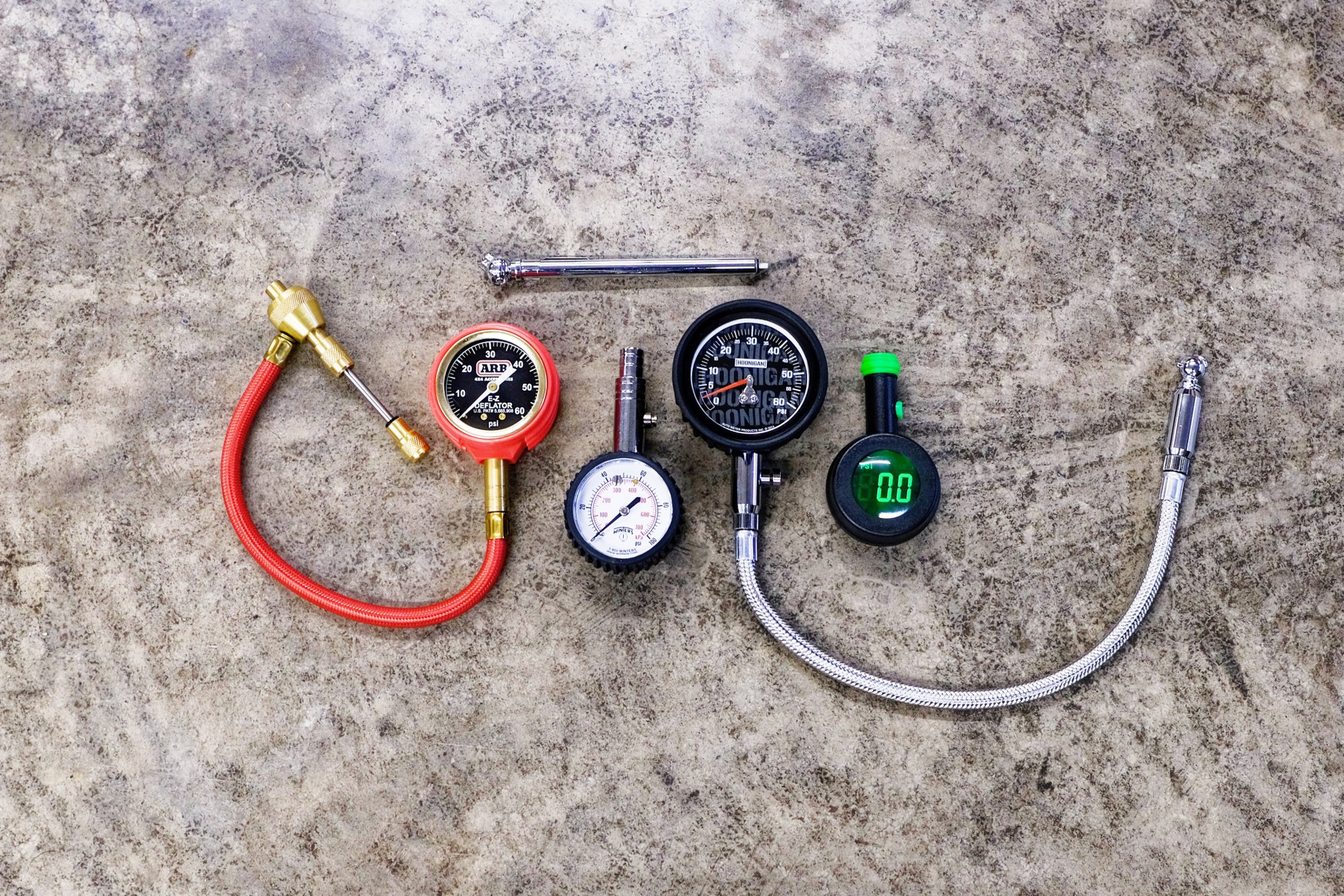 Motors
Motors
The Best Tire Pressure Gauges of 2024
Maintaining proper tire pressure is crucial for vehicle safety and fuel efficiency. Explore our guide to the best tire pressure gauges to help you keep your tires properly inflated.
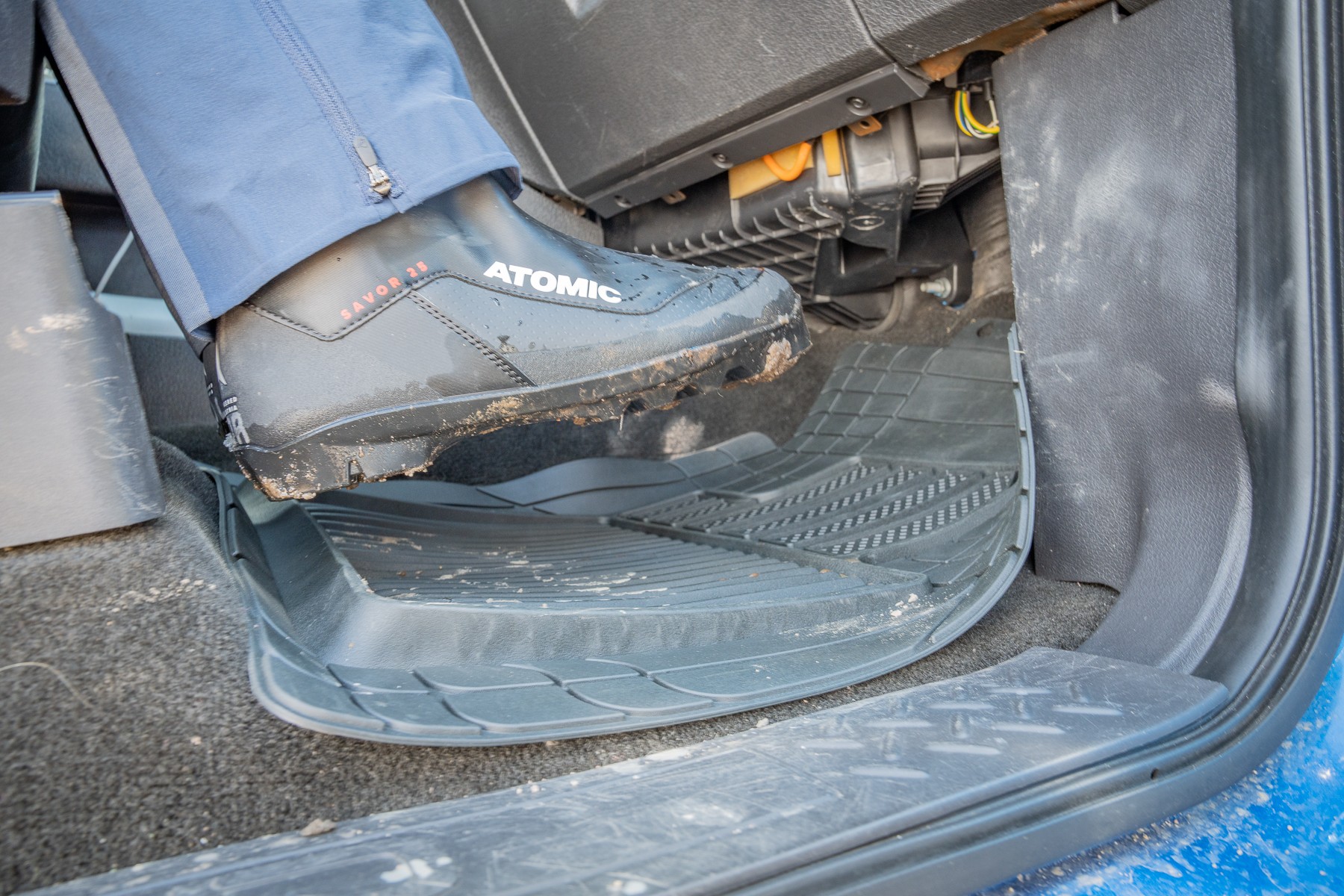 Motors
Motors
The Best Car Floor Mats of 2025
Keep your car’s interior clean and protected with our recommendations for the best car floor mats of 2025, featuring top brands like WeatherTech and Husky Liners.
